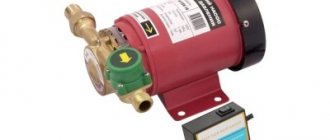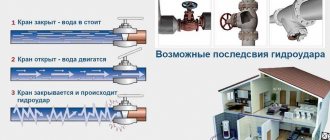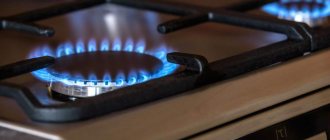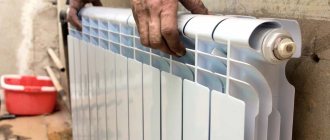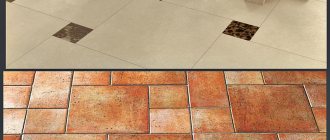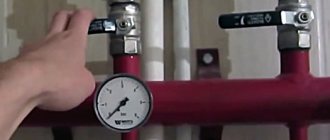The concept of warm floor
Laying warm floor coverings and warm water floors in apartments in European countries has been done since the 80s of the last century. In Austria, Switzerland and Germany, water heated floors in apartments are installed in 60% of houses. Various energy sources are connected to heating for underfloor heating:
- infrared emitters;
- heating electrical cables;
- PLEN device, films with a built-in electric spiral and others.
The heated floor and the technology for its implementation in the case under consideration involve heating through a laid pipeline with hot liquid, most often it is water, sometimes antifreeze or antifreeze is used. Laying a water heated floor requires laying the pipes evenly over the floor surface.
When circulating, the liquid in the heating system passes through a centralized heating source, transfers heat to the concrete, and then heats up the air. The technology for laying water heated floors involves heating water with an autonomous boiler, or heated floors in the apartment are connected from central heating. In both cases, you can turn on and install the water heated floor yourself.
Modern technologies simplify the installation of water heated floors. Pipes are used whose configuration is based on the molecular memory of cross-linked polyethylene. This has reduced the cost of materials, the connection diagram for a water heated floor and the installation technology have become simpler, and reliability has increased.
Installing and pouring a heated floor is not a complicated process; making a water heated floor with your own hands is quite possible. For this purpose, several techniques and special materials have been developed. People show interest in how to connect the warm floor of a room to the heating system, and how to implement this project on their own.
Pipe length calculation
How to calculate the length and lay pipes on a heated water floor will be discussed below. There are several options for how heating pipes should be installed in a water-heated floor: in a snail shape or in straight parallel lines, or in other ways. But the main requirement is met everywhere.
The pipes are distributed evenly, the total length covering a certain area depends on the pitch between them. To meet the conditions for heating with underfloor heating, you need to correctly calculate the length of the pipe. To simplify the process, the pipe flow calculated for different options is summarized in a table.
Consumption of underfloor heating pipe depending on the loop pitch
| Pitch, mm | Pipe consumption per 1 m², m.p. |
| 100 | 10 |
| 150 | 6,7 |
| 200 | 5 |
| 250 | 4 |
| 300 | 3,4 |
Using the table, it is easy to understand how to do the calculations yourself. With a room area of 20 m and a laying step of 20 cm, the length (L) will be equal to 20 m2, multiplied by 5 linear meters/m, which will be 100 m. The length of the warm coating circuit should not exceed 70 m, this is due to the effective circulation of the coolant through the pipeline and pump capacities. If the pipe in the circuit exceeds 70 m, warm floors are not effective, then how to make the right choice?
The pitch is set to 300 mm. Length (L) = 20 m2 * 3.4 linear/m = 68 m. This fully meets all requirements. In a large room, several lines are installed, but individual heating circuits should not exceed 70 m. Using powerful pumps, it is possible to connect a warm water floor circuit up to 120 m.
How pipes are laid
The laying technology for heated floors clearly determines what to fill the warm water floor with. There are ready-made mixtures that just need to be diluted with water in the concentration specified in the instructions. In some cases, a water-heated floor is made without a screed when the floor is made of plywood. If chipboard is laid with laminate, parquet, linoleum, it is not necessary to fill the heated floor with screed mortar. Dry screed is successfully used for warm water floors.
Before pouring and installing the floor covering, the pipes are checked for leaks. A special compressor is used, water is pumped into the pipes under a pressure of 6 bar, a process called pressure testing. If the pressure has not dropped by more than 1.5 bar during the day, the heating circuit is sealed. An incorrectly made heated floor or poor-quality installation can lead to the need to dismantle the floor covering.
Connecting a “warm floor” to a battery
The floor line is connected to the supply or return circuit. This installation can be carried out in city apartments only with the permission of government authorities, therefore such schemes are used only in private cottages.
- If there is one radiator installed in the room, then a separate circuit is connected to the “warm floor” from above it. A filter, an air tube and a circulation pump are installed on the pipe. It pumps coolant into the water main.
- The other end of the line is connected to the radiator from below. The cooled coolant is discharged from the battery through the return pipe to the boiler.
- The circulation pump is equipped with a thermal head or servo drive. When the water temperature in the floor circuit increases, the pump stops working. Heating stops. Only radiator heating is operational.
It is possible to connect a “warm floor” from a battery using a different scheme, to the return pipeline. A bypass is provided for hot and chilled water. Install automatic temperature control for the floor.
- Remove the loop from the return pipe.
- A three-way valve, with a thermal head, and a circulation pump are installed on it.
- A floor line is removed from the pump.
- The other end of the pipe is connected via a bypass to the heating return circuit. Cooled water passes through it to the boiler. The distance between the supply and return connections should not be less than 30 cm.
- A two-way valve with a thermal head is installed on the bypass. When the temperature in the floor line rises, the valve shuts off the outlet of cold liquid to the boiler. Through the bypass it flows to a three-way valve, where it is mixed with the hot coolant.
- When the thermal conditions are normalized, the two-way valve opens the outlet for chilled water. She goes back into the furnace.
We recommend: How is the length of a heated floor pipe calculated?
The connection of the “warm floor” to the battery must be carefully calculated. When installing a high-power boiler, the floor temperature may be higher than normal. It will be impossible to walk on it. For each room, an automatic system is installed that regulates the thermal regime.
YouTube responded with an error: The request cannot be completed because you have exceeded your quota.
- Related Posts
- Features of Korean heated floors
- How to calculate the length of a heated floor?
- How does a comb for heated floors work?
- Features of installation of heated floors Sun power
- How is the mesh for underfloor heating installed?
- What types of mats are there for warm water floors?
Main advantages
Compared to the old technology with radiator batteries, the new technique has a number of advantages:
- A heated layer at the level of the feet of human feet. Feet are warm, head is moderately cool - this stimulates the human body to active life.
- The labor-intensive procedure of removing dust from hard-to-reach areas of radiators is eliminated.
- Uneven heating stimulated colds. In the case of heated floors, all these disadvantages are absent, the surface is easy to sweep and wash;
- Space is freed up, there is no need to think through options for how to fit radiator batteries and pipes into the interior of the room;
- Installation work has become much easier;
- Carrying out the work and the main elements of the system are cheaper. To heat the room, a temperature in the pipes of 55 ̊C and no more than 60-70 ̊C is sufficient. Installation and further operation of heated floors turns out to be 30% cheaper. Therefore, many people wanted to know how to make a water-heated floor.
Warm floor from central heating
Organizational matters
Many apartment residents want to dismantle the radiators or additionally connect them to underfloor heating from central heating. Before starting such a reconstruction, it is necessary to resolve organizational issues, namely, coordinate the project with the management company that services the house.
Unauthorized connection to the central heating system is punishable by very high fines, in addition, they will subsequently be forced to dismantle all installed equipment.
The difficulty in the question of how to make a heated floor is the process of obtaining permission. The difficulty is that most boiler houses operate at the limit of their calculated power or have a small reserve. Several apartments can be connected; with a mass connection, the central system will not be able to function normally.
Connecting a water heated floor to a heating system has some technical difficulties. This depends on the design of the central system. So, in schemes with direct supply through one pipe, there are no options for connection. Where the coolant circulates along the circuit of forward and reverse pipes, connection is possible.
The location of the heat exchanger largely influences the decision of the management company. When the heat exchanger is located in the lower part, residents of the upper floors are more likely to receive a permit, and vice versa. After obtaining permission, you can purchase equipment and begin installation work on the central heating floor.
Connection diagram
Diagram for connecting a heated floor to a central heating system
Before pouring the pipes laid on the floor, the entire installation diagram is checked for the tightness of the heated water floor. Depending on the length of the circuit and the diameter of the pipes, the pump power is selected. The installation scheme for heated floors includes the following main elements:
- Valves at the entrance to the heated floor circuit;
- Check valve;
- Three-way control valve (thermal head);
- Circulation pump;
- Coolant temperature control sensor;
- Manifold for underfloor heating;
- Plastic pipes.
The scheme for installing a water heated floor begins with connecting the central heating system to the return line. Two valves are installed to drain the forward and reverse flow of the underfloor heating system. They are designed to allow you to turn off the water at any time and carry out repairs or maintenance of elements in the heated floor line.
The check valve ensures that the coolant fluid moves in one direction. The three-way valve is of great importance in the system; it distributes hot and cold flows, mixing them until the set temperature is reached. Sometimes this device is called a thermal head. The temperature of the water entering the heated floors from the central system can reach 70 °C, this is too much; for normal operation no more than 50 °C is required. The thermal head reduces the temperature to the value set on it, usually 40-45 ̊C.
The circulation pump circulates water within the circuit in a given direction. Temperature sensors indicate the temperature of the coolant. There are automatic control systems that combine the operation of sensors and three-way valves, but this topic requires a separate, more extensive description.
Might be interesting
Thermal insulation
How to insulate a roof from the inside and not make mistakes?
Thermal insulation
Roofing and drainage: heating rules
Thermal insulation
Insulated Swedish stove: pros and cons
Thermal insulation
Penoizol: self-production
A manifold for underfloor heating distributes coolant flows through pipes of different circuits. Return line underfloor heating collectors collect cooled flows, directing them to a three-way valve, where the liquid is distributed by a thermal head for further circulation in a closed circuit, maintaining the temperature set in it. Manufacturers make manifolds for heated floors from various materials:
- Brass products are durable and strong, withstand high pressure, they are universal for any type of pipe;
- Manifolds for underfloor heating made of copper can withstand the highest pressures of up to 30 bar and high temperatures in heating systems. Often used in circuits where the coolant can be oil, antifreeze or antifreeze.
- Stainless steel parts are in greatest demand due to reasonable prices and good technical characteristics that satisfy installation in apartments.
This is what the distribution manifold looks like
Three way valve design
The heating system to which heated floors are connected necessarily includes a three-way valve; its design and principle of operation require detailed consideration. Essentially, the valve works like a mixer of hot and cold water, you can make it warmer or colder.
When moving the shut-off element in the adjustment sector, the space for the flow of hot liquid increases and the space for the flow of the cold part of the coolant decreases and vice versa. In this way, the temperature in the system can be controlled. This diagram of a water circuit with a valve helps to better understand its purpose and operating principle.
Warm floor - three-way valve connection diagram
Valves with electric drives are sometimes used in conjunction with thermostats. Water flows are adjusted automatically depending on temperature changes. When it decreases, the valve shut-off device moves in the direction of increasing the hot flow, and, conversely, when the set temperature value increases, the electric drive moves the shut-off mechanism in the direction of increasing the cold flow.
Features of the circulation pump
Whether the entire system will work efficiently depends on the correct selection and installation of the pump. The circulation of the coolant depends on the length and diameter of the pipes; bends at pipe turns make it difficult to move the flow. To achieve the required rate of fluid circulation in the system, a pump is installed. Consumers have a greater preference for pumps with three pumping speeds; this makes it possible to control the temperature of the coolant, and therefore the air in the room, by changing the circulation speed.
Circular pump and its technical characteristics
When the room temperature drops, the coolant in the pipes will cool faster. By increasing the circulation rate, flows will pass through the heating element more often, increasing the temperature. The speed switch is located on the pump body and is controlled manually. There are options when the entire process is controlled by an automatic system.
Manufacturers produce two types of pumps: with a wet and dry rotor, in the first version the rotating part is in the circulating fluid, in the second version the rotor is isolated. A wet rotor is more suitable for apartments; their power is limited for rooms of 400 m2, this is quite enough. They consume less electricity and operate silently. The pump body can be made of stainless steel, cast iron or polymer; the latter option is optimal, lightweight, strong and durable.
The numbers separated by a fraction sign on the marking indicate the dimensions of the inlet and outlet holes, the last number indicates the length of the product for calculations during installation work. In order not to go into details when calculating a pipe for a heated floor, use a table to calculate the calculations when choosing a pump.
Characteristics table for pump selection
| Heating area, m² | Pump capacity | |
| radiator heating | warm floor | |
| 80-120 | 0,4 | 1,5 |
| 120-160 | 0,5 | 2,0 |
| 160-200 | 0,6 | 2,5 |
| 200-240 | 0,7 | 3,0 |
| 240-280 | 0,8 | 4,0 |
| 300-350 | 1,2-1,5 | — |
When installing the pump in a line, you cannot confuse the direction of movement of the coolant; it is indicated by an arrow on the body. The rotor must be in a horizontal position; when installed vertically, the pump power is reduced by 30%.
The pump can be placed on any section of the main line, but most often this is done at the entrance to the system after the switchgear or thermostat. It is very important that the pump is equipped with an air release valve. An air lock can block the circulation of the coolant and the operation of the pump; opening the valve will help get rid of accumulated air in the interval in the network where the pump is installed.
Double-circuit floor-standing gas boilers
In the second part of our review of heating and water supply systems, we will analyze systems based on double-circuit gas boilers. After all, it would seem that one device that heats water both in batteries and in the hot water system is a very convenient choice, but not everything is so ideal.
Firstly, floor-standing double-circuit gas boilers (they are also called combined gas-water-heating units, abbreviated as AKGV), as a rule, have a very low hot water output. This means that it is almost impossible to provide comfortable hot water supply in a house in which there are more than 2 hot water points.
Secondly, floor-mounted double-circuit floor-standing boilers are usually produced with a power of up to 25 kW, which are designed for houses up to 200 m2. Although this second point follows from the first: it is difficult to imagine a house with an area of more than 200 square meters, which has only 2 points for dispensing hot water.
Thirdly, you must be aware that if you use a floor-standing double-circuit boiler, then it must work both in winter (for heating and hot water) and in summer (only for hot water). In this case, your heating system must be installed in such a way that the heating circuit is closed for the summer using taps and bypasses, and the boiler is not in the kitchen, but in a separate boiler room. Otherwise, being in a house where a double-circuit floor-standing boiler is running in the summer will be almost unbearably hot.
Fourthly, there is always water in your heating and hot water systems, which means that leaving the house unattended for a long time can result in the system defrosting. After all, the boiler can go out due to a gas shortage or a banal gust of wind.
Let's move on to the advantages of double-circuit floor-standing boilers. They exist too!
All the advantages of AKGV lie in their simplicity, and therefore reliability. The vast majority of these devices are non-volatile. This means that the heating system will operate without electricity (provided that it is installed correctly). All spare parts for such boilers are available and finding anything for it will not be difficult. The simplest repair of an AKGV boiler can be performed by anyone, which is extremely important for remote and hard-to-reach settlements.
The summary of everything written is as follows: a double-circuit floor-standing gas boiler will be optimal for small and medium-sized houses (up to 200 m2), with natural gravity circulation of the coolant and a small number of hot water collection points located in rural areas.
Connection to an individual heating boiler
The presence of an individual heating boiler in an apartment or private house eliminates all organizational problems in permitting the installation of water heated floors. In this case, connecting a warm water floor does not require any permits. Depending on the location and operation conditions of the facility, boilers can be of various types:
- on gas fuel;
- on liquid fuel (diesel, fuel oil);
- solid fuel: firewood, pellets, coal;
- electrical;
- combined.
In apartments in multi-storey buildings, gas or electric heating boilers are most often used; connecting a heated floor circuit to the central heating system is not required. In this case, the diagram differs slightly, but the functional purpose of the main elements remains the same.
Diagram of a water heated floor system in a private house with an autonomous boiler
Essential elements:
- boiler;
- expansion tank;
- pressure gauge;
- circulation pump;
- manifold for underfloor heating;
Unlike the case with central heating, connecting a heated floor to a boiler does not require installing a three-way valve to regulate the temperature of the coolant. Its installation is not necessary; the temperature can be changed from the boiler control panel. Temperature control sensors are also located on the external control panel.
The expansion tank serves to maintain stable pressure in the system; when heated, the volume of liquid increases. To prevent the underfloor heating collector, pump and other expensive elements in the pipeline system from collapsing, the tank compensates for the expansion of the coolant volume. The pressure gauge shows the pressure in the pipes. The main thing is that before pouring the solution into a warm floor, you need to check the functionality of all components.
Control panel on the boiler body
Regardless of the modification of the device and its manufacturer, all panels have basic options, and some additional programming functions:
- buttons or regulators for increasing and decreasing the supply coolant temperature;
- button for automatically setting a comfortable, economical temperature mode, room temperature – 20-22 ̊C;
- It is possible to program control, set the modes “winter”, “summer”, “vacation”, “function of protecting the system from freezing of liquid”.
How to make specific settings for boilers with different control panels is described in the operating instructions. Filling a water heated floor with a solution for a separate boiler is done in the same way as for central heating.
Remote control panel
The warmth continues on its way
Through pipelines from the thermal power plant, the coolant (water) comes to the pumping station (PS). Its task is to create a hydraulic regime at heat supply facilities. The coolant pressure from the thermal power plant is very high, it needs to be reduced to normal parameters to supply it to heat supply facilities, in addition, the distances to the facilities can be quite large, and the pressure in the pipes can change. Special NPS equipment regulates the carrier pressure in order to transfer heat further to central heating points. This is the main goal of the station - to bring the pressure to the required standards. What's next? The cycle continues: at the central heating point (CHS), the coolant releases energy to transfer heat to the heating and hot water supply system of houses, where it is distributed among apartments and comes to each battery. After the heat is released, it returns back to the central heating point, then to the pumping station, from where it is sent back to the thermal power plant by pumps.
The main requirement for everyone inside the pumping station is to wear a hard hat. Only specialists can touch pipes, levers and everything else. The equipment operates under high voltage - over ten thousand volts. Therefore, just out of curiosity, you can’t touch anything - it can be life-threatening.
There are a total of 24 pumping stations in Moscow.
Video: water heated floor in an apartment
All this shows that it is preferable to make heated floors with the installation of an autonomous heating boiler; the main part of the installation can be done with your own hands. A water floor made without a screed, or a dry floor with a screed, will simplify the work and make it cheaper.
If the connection diagram for a heated floor is not entirely clear, you can and should consult with professionals about individual elements in the floor. Having studied the purpose, the correct connection of the main elements into the overall scheme, technically literate people understand that laying a heated floor is not difficult, making a heated floor with your own hands is a very real task.
